About Our Contributors
Grandmaster Puzzles is proud to present its up-to-date list of Contributing Puzzlemasters. Selection is difficult and generally requires a solid length of time producing amazing puzzles (while many can be Contributors, few can be considered Puzzlemasters too!). The people on this list are here because they are some of the finest puzzlemakers around.
 |
Grant Fikes has been experimenting with logic puzzle construction for many years, first on LiveJournal and then, after honing his craft, on Blogspot. His “A Cleverly-Titled Logic Blog” now has over 700 puzzles. Grant’s puzzles have appeared in Akil Oyunlari, Sudoku Xtra, the 2012 and 2013 US Puzzle Championships, and two Logic Masters India tests co-authored with Palmer Mebane. Grant is also the designer of the board game Battle of LITS, a two-player game inspired by the logic puzzle LITS. |
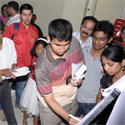 |
Prasanna Seshadri is a puzzlemaster from India. In 2013, he was the Indian Double Champion, winning both the Indian Sudoku and Puzzle Championships. He holds the best individual ranking by an Indian at the World Sudoku Championship (7th) and World Puzzle Championship (2nd). As a puzzlemaker, Prasanna co-authored the Sudoku Mix book released by Logic Masters India and has contributed to many championships including the WPC, the 24HPC, and the Sudoku and Puzzle Grand Prix series. He plays an important role in expanding puzzling in India by helping with the LMI Beginners’ contests and by organizing workshops and events like Brain Games, Sudoku Mahabharat, and Puzzle Ramayan. He was the lead trainer of the Indian Juniors Team that placed 2nd at the WJSC in 2015. Many of his puzzles can be found on his puzzle blog where he has been posting since January 2012. |
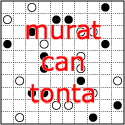 |
Murat Can Tonta, or anagrams thereof, is a puzzlemaster from Turkey. An enthusiastic puzzle solver for years, he was inspired by the magazine Akıl Oyunları and authors like Serkan Yürekli to try his hand at designing puzzles. A regular contributor to Akıl Oyunları until its discontinuation, Murat has also authored three puzzle books, a puzzle set for Logic Masters India, and puzzles for the World Puzzle Championship, LMI qualifiers, the 24HPC, and inter-school competitions. He is an author and judge at PuzzlePicnic. His hobbies include narrowly failing to qualify for the WPC every year, though he mostly quit this hobby in recent years. |
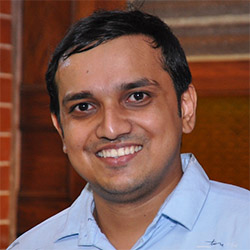 |
Ashish Kumar is a passionate puzzle creator from Chennai, India. He started puzzling in 2012 and over the years since has become a regular top Indian puzzle solver and constructor. Ashish has contributed puzzles to numerous online tournaments including the WPF Sudoku and Puzzle Grand Prix series, the 24HPC, the Brand’s Sudoku Cup, the UK Sudoku and Puzzle Championships, and the Sudoku Mahabharat and Puzzle Ramayan series. Ashish was part of the puzzle constructing team for the World Sudoku and World Puzzle Championships in 2017 hosted by India. His book, Enthralling Sudoku, hit the charts in 2018 and garnered great reviews. He plans to release a sequel soon. He has also authored a few e-books for Grandmaster Puzzles. |
 |
John Bulten, former puzzle editor for news network WND, is a groundbreaking enigmatologist. He read GAMES magazine in the 70s and became an expert on sudoku and Bible codes in the 80s, before any of them were mainstreamed. A voluble National Puzzlers’ League and “Word Ways” author, John invented the 3-D crossword and coauthored the first word-rank crossword dictionary. John organized tournaments as director of the Tulsa Scrabble Club but claims no need to defend his top 100 ranking; he would rather keep teaching puzzlemaking to his wife and three children, and publishing unique research and analysis on ancient enigmas and modern puzzles. |
 |
Palmer Mebane, or MellowMelon online, is a puzzlemaster from the USA. He works as a developer and educator at Art of Problem Solving and spends the rest of his time on math problems or logic puzzles. He won the US Puzzle Championship in 2011 and 2013, and he was 1st after the preliminary rounds at the 2013 World Puzzle Championship. On the authoring side, he has posted hundreds of puzzles on his former blog Melon’s Puzzles, and he cowrote a number of competitions such as both Fillomino-Fillias at Logic Masters India (with Grant Fikes) and the Team USA rounds for the 24HPC in 2012 and the WPC in 2013 (both with Thomas Snyder and Wei-Hwa Huang). |
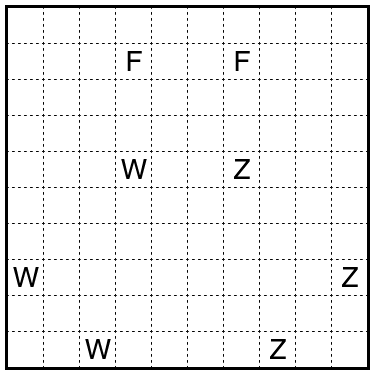 |
JinHoo Ahn is from South Korea and majored in mathematics, focusing on mathematical logic. JinHoo enjoys solving many kinds of puzzles, particularly logic puzzle video games. As a puzzle designer, JinHoo first gained notice for mechanical puzzles. His first puzzle, Double G (or G&G), won a Jury Grand Prize at the Nob Yoshigahara Puzzle Design Competition in 2012, and two other puzzles won awards in 2014 and 2016. JinHoo only recently started designing logic puzzles, initially thinking that logic puzzle design was meaningless as there were too many computer-generated puzzles out there. But after finding GMPuzzles in 2017, JinHoo discovered that logic puzzles can have beauty in their visual themes and solving steps and he began trying to create elegant puzzles. Many of his early submissions have earned “Best of” the year awards including the Three Types Pentominous puzzle shown here. His first book of logic puzzles, Star Battle, was published at the end of 2020. |
 |
Tom Collyer has been solving puzzles since the Times ignited the worldwide sudoku craze in 2004. Initially something of a sudoku specialist, his puzzling enthusiasm was further developed after discovering nikoli.com. Deciding this was an excellent distraction to his PhD studies, in 2009 he began publishing a regular “Friday Puzzles” feature on his blog detuned radio, which continues to this day. He has also been heavily involved with the newly founded UK Puzzle Association. As a solver, he is a regular fixture at WSC’s and WPC’s representing the UK; as an author, he was the Competition Director of the 9th WSC, and has also organized and contributed to numerous international competitions, as well as the Daily League sudoku project. |
 |
Carl Worth first gained his love for puzzles by growing up in a puzzle-loving family with a subscription to GAMES magazine and regular brainteasers posed at the dinner table (Martin Gardner was a frequent source). He finds that puzzle-solving shows up in many of his activities, from computer programming to rock climbing. His interest in puzzle construction began with a set of annual Christmas puzzles he has written for his children for several years. He now contributes regularly within the National Puzzler’s League and has also had puzzles featured in the US Puzzle Championship. |
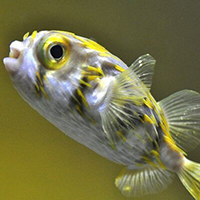 |
Takeya Saikachi is a puzzlemaker from Japan. When he was young, around the early 1990s, he first discovered puzzles through the magazine Puzzler (which was introducing many new puzzle types like Skyscrapers and How Many Kinds? at the time). By the early 2000s, Takeya was designing some of his first puzzles, and had a few accepted for publication in Nikoli’s magazines; he also started competing at puzzles, placing 3rd at the 2004 Japan Puzzle Championship and competing in his first World Puzzle Championship that year. The international experience made Takeya even more excited to create logic puzzles. In the following years, Takeya has finished as high as 13th (unofficial) at the 2013 WPC, and has contributed puzzles to many different books, magazines (like Akil Oyunlari), and competitions (like 24hPC). In 2013, Takeya was part of the founding team of six puzzlemakers to self-publish the puzzle magazine “Toketa?”, which continues to be released once a year. |

Dear Ashish—
When I solve triple treasure nice puzzle!) I look for symmetric sets: squares in the same region which are adjacent to the same numbers. Since the puzzle always has a unique solution, squares in a symmetric set are all filled or all empty. The 4/26 Sunday Times puzzle has 12 symmetric sets, so this makes for a lot of progress. Do you think this is an “ethical “ method?